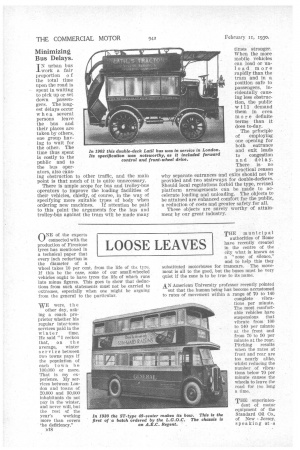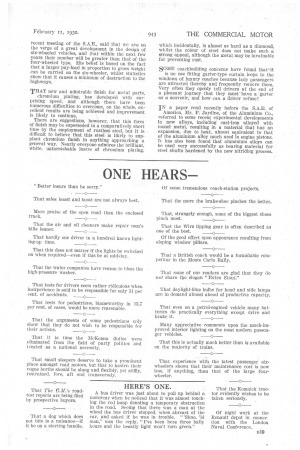LOOSE LEAVES
Page 96

Page 97

If you've noticed an error in this article please click here to report it so we can fix it.
ONE of the experts connected with the production of Firestone tyres has mentioned in a technical paper that every inch reduction in the diameter of a wheel takes 10 per cent, from the life of Mc tyre. If this be the case, some of our small-wheeled vehicles ought to have tyres the life of which runs into minus figures. This goes to show that deductions from such statements must not be carried to extremes, especially when one might be arguing from the general to the particular.
WE were, the
other day, asking a coach proprietor whether his regular inter-town services paid in the winter time. He said "I reckon that, on the average, winter service between two towns pays if the population of each town be 100,000 or more. That is my experience. My services between London and towns of 20,000 and 30,000 inhabitants rio not Pay in the winter, and never will, but the rest of the
year's working more than covers the deficiency." o18 THE municipal authorities of Rome have recently created in the centre of the city what is known as a zone of silence," and to help this they substituted motorbuses for tramcars. The movement is all to the good, but the buses must be very quiet if the zone is to be true to its name.
AN American University professor recently pointed out that the human being has become accustomed to rates of movement within a range of 70 to 140 complete vibrations per minute. The most comfortable vehicles have suspensions that vibrate from 100 to 140 per minute at the front and from 70 to DO per minute at the rear. Pitching results when the rates at front and rear are too nearly alike, whilst reducing the number of vibrations below 70 per minute causes the wheels to leave the road for too long a time.
THE superinten dent of motor equipment of the Standard Oil Co., of New Jersey, speaking at a
recent meeting of the S.A.E., said that we are on the verge of a great development in the design of six-wheeled vehicles, and that within the next few years their number will be greater than that of the four-wheeled type. His belief is based on the fact that a larger pay-load in proportion to gross weight ' can be carried on the six-wheeler, whilst statistics show that it causes a minimum of destruction to the 'highways.
THAT new and admirable finish for metal parts, chromium plating, has developed with surprising speed, and although• there have been numerous difficulties to overcome, on the whole, excellent results are being achieved and improvement is likely to continue.
There are suggestions, however, that this form of finish may be superseded in a comparatively short time by the employment of ,rustless steel, but it is difficult to believe that this steel is likely to supplant chromium finish in anything approaching a general way. Nearly everyone admires the brilliant, white, untarnishable lustre of chromium plating, which incidentally, is almost as hard as a diamond, whilst the colour of steel does not make such a strong'appeal, although the metal may be invaluable for preventing rust.
SOME coktchbuilding concerns have found that it is no use fitting garter-type curtain loops to the windows of luxury coaches because lady passengers are attracted thereby and frequently remove them. Very often they openly tell drivers at the end of a pleasant journey that they must 'have a garter as a souvenir, and how can a driver refuse?
IN a paper read recently before the S.A.E. of America, Mr. F. Jardine, of the Aluminium Co., referred to some recent experimental developments In new alloys, including cast-iron alloyed with monelmetal, resulting in a material that has an . expansion, due to heat, almost equivalent to that of the aluminium alloy much used in engine pistons. It has also been found that aluminium alloys can be used very successfully as bearing material for steel shafts hardened by the new nitriding process.




























































































































































































































